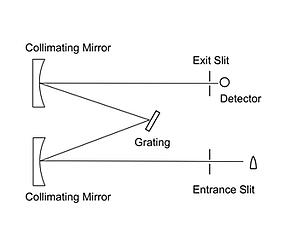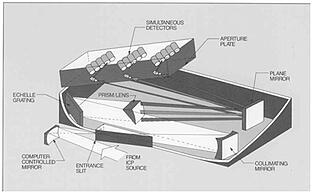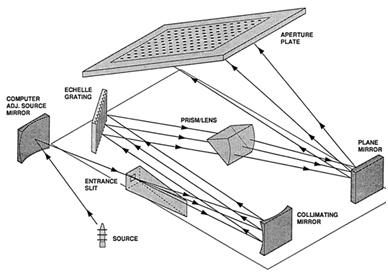In part I of the Evolution of ICP, we focused on the first decade of ICP instruments, which were based on the Paschen-Rünge optical design. In part II of the blog series, we jump into the 1980s, and the next era in innovation.
The wavelength restrictions associated with the Paschen-Rünge optical design led to the development of sequential spectrometers in the early 1980s. Most of these instruments relied on the principle of scanning a dispersive optic (typically a ruled or holographic diffraction grating) to select the specific wavelength of light corresponding to the element of interest. These instruments were extremely versatile, possessing the ability to access nearly any wavelength in the electromagnetic spectrum from 160 - 900 nm. Their downside lay in their ability to access only one wavelength at a time (thus named sequential), resulting in slow analysis times. On an instrument of this type, a typical analysis could take several minutes to cover the 10 to 20 elements of interest. A schematic diagram of a typical scanning sequential spectrometer is shown in the schematic below:

Additional improvements in wavelength versatility were achieved in the early 1980s with the development of the echelle optical system introduced by Teledyne Leeman Labs. These instruments relied on a high dispersion echelle grating in combination with a second dispersive optic (usually a prism) to produce a 2-dimensional spectrum or Echellogram. One of the hallmarks of echelle spectrometers is that they produce very high resolution spectra from relatively small optical systems; typical only 0.3 to 0.8 meters in length. Teledyne Leeman Lab’s early echelle spectrometers were capable of accessing more than one wavelength at one once (simultaneous), as well as sequential or even a combination of both, using a single optical system. The result was an instrument with both high speed and versatility in one compact benchtop configuration. The graphics below depict a typical 2-Dimensional Simultaneous Echelle Spectrometer and a Sequential Echelle Spectrometer.


At the same time as Leeman Lab’s development and introduction of the echelle optic system, other manufacturers began offering combination units incorporating both Paschen-Rünge simultaneous spectrometers and scanning sequential spectrometers in one large instrument. Both of these approaches (Echelle or combination Paschen-Rünge/Sequential Spectrometer) gave the user the capability of high throughput for routine samples and the versatility to quantify nonroutine samples when trace element demands changed.
And so the world of ICP-OES analysis was beginning to broaden, capable of analyzing a variety of sample matrices and elements of interest. Be sure to read our next blog “The Evolution of Evolution of ICP Part III - The 1990s” as we continue to trace the development of ICP and the technological promises of today’s most useful technique for trace multi-element analysis.
Teledyne Leeman Labs ICP Spectrometers are considered a workhorse in the industry. For more information on these ICP-OES Spectrometers, visit our website or contact us for more information.
References
- Thomas, Robert. Practical Guide to ICP-MS: A Tutorial for Beginners; CRC Press, Taylor & Francis Group: Boca Raton, 2013; p xxi.

